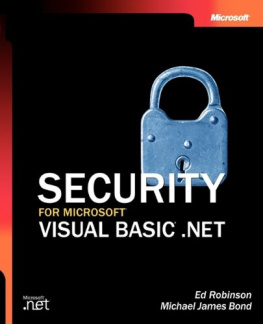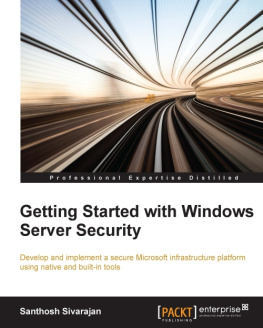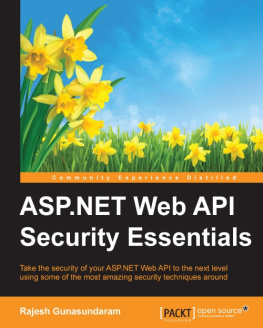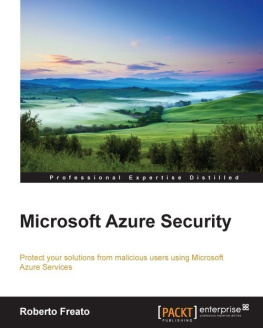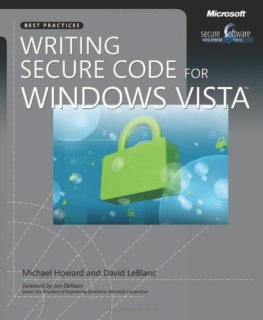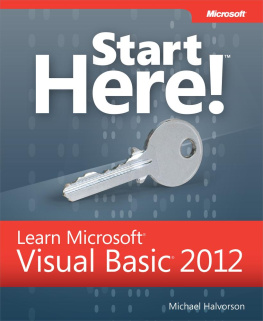Security for Microsoft Visual Basic .NET
PUBLISHED BY
Microsoft Press
A Division of Microsoft Corporation
One Microsoft Way
Redmond, Washington 98052-6399
Copyright 2003 by Ed Robinson and Michael Bond
All rights reserved. No part of the contents of this book may be reproduced or transmitted in any form or by any means without the written permission of the publisher.
Library of Congress Cataloging-in-Publication Data
Robinson, Ed, 1967
Security for Microsoft Visual Basic .NET / Ed Robinson, Michael James Bond.
p. cm.
Includes index.
ISBN 0-7356-1919-0
1. Computer security. 2. Microsoft Visual Basic. 3. Basic (Computer program
language). 4. Microsoft .NET I. Bond, Michael, 1965- II. Title.
QA76.9.A25R635 2003
005.8--dc21 2003043634
Printed and bound in the United States of America.
1 2 3 4 5 6 7 8 9 QWE 8 7 6 5 4 3
Distributed in Canada by H.B. Fenn and Company Ltd.
A CIP catalogue record for this book is available from the British Library.
Microsoft Press books are available through booksellers and distributors worldwide. For further information about international editions, contact your local Microsoft Corporation office or contact Microsoft Press International directly at fax (425) 936-7329. Visit our Web site at .
Microsoft, Microsoft Press, the .NET logo, Visual Basic, Visual Studio, and Windows are either registered trademarks or trademarks of Microsoft Corporation in the United States and/or other countries. Other product and company names mentioned herein may be the trademarks of their respective owners.
The example companies, organizations, products, domain names, e-mail addresses, logos, people, places, and events depicted herein are fictitious. No association with any real company, organization, product, domain name, e-mail address, logo, person, place, or event is intended or should be inferred.
Acquisitions Editor: Danielle Voeller Bird
Project Editor: Denise Bankaitis
Technical Editor: Christoph Wille
Body Part No. X09-39065
To my wife, Catherine, and to my mum, Dorothy
E.S.R.
To my wife, Jane, for her love and support; to my daughters Sarah and Katie, for their encouragement; and to my daughter Jessicamay you be born happy and healthy this June.
M.J.B.
About the Authors
Ed Robinson
Ed Robinson, a lead program manager for Microsoft, helped drive the development of security features for Visual Basic .NET and other Microsoft products. He has 13 years of experience in the software industry and speaks at developer conferences worldwide.
Michael Bond
Michael Bond is a development lead on the Visual Basic .NET team. He has supported, developed, and helped secure many features of Visual Basic over the past 13 years. You can find Mike in the Visual Basic chat rooms on MSDN, Microsoft Developer Network, as well as at industry events.
Introduction
we explain what encryption is and when to use the different types of encryption, and we provide examples that show you how to actually encrypt and decrypt information.
Although there is already a wealth of information available about security, very little has been written that targets the Visual Basic programmer. In writing this book, we set out to change this. We have followed three principles that make this book better for the Visual Basic programmer than any other publication you will find on security:
Make it simple Many security publications are shrouded in hard- to-understand jargon and difficult-to-work-out acronyms, and they assume you already have a background in security. This book is different: we spell out every acronym, use easy-to-understand language, and explain in clear terms each security concept.
Clear guidance Some security books explain security techniques without telling you where or where not to use them. This book is different: we offer clear guidance on how, when, and where you should use each security technique.
Complete assistance Although this is an introductory-level book, it covers everything from coding techniques to designing a secure architecture to performing a security audit. Our intention was to provide an end-to-end introductory guide for producing secure applications.
How to Use This Book
The authors of this book, like you, are Visual Basic programmers. We use straight, no-nonsense talk, offer clear and simple solutions, and provide step- by-step exampleswritten entirely in Visual Basic, of course. To make it easier to find what youre looking for, this book is divided into four sections, each section dealing with a different aspect of security:
jumps straight into programming techniques such as encryption, role-based security, code access security, Microsoft ASP.NET authentication, and securing Web applications.
is about identifying threats to your Visual Basic .NET application and neutralizing them by safe-guarding input, properly handling exceptions, and testing your application for security vulnerabilities.
discusses how to lock down the environments that your application runs in or depends upon such as the Microsoft Windows operating system, Internet Information Services, .NET runtime, Microsoft SQL Server, and Microsoft Access databases. In addition, this section discusses how to lock down your application for deployment.
focuses on architecture, how to design secure systems, perform a security audit of your application, come up with a contingency plan, and execute the contingency plan if an intruder does make his or her way past the security measures you have put into place.
Microsoft Visual Basic .NET is built on a number of technologies, including the .NET platform, Microsoft Visual Studio .NET, and of course the Microsoft Visual Basic .NET compiler. For the sake of simplicity and brevity, unless the distinction is important, we refer to all of these technologies collectively as Microsoft Visual Basic .NET. As a Microsoft Visual Basic .NET developer, you dont need to think about these composite technologies to get your job done.
How to Use the Code Samples
Youll find many samplesboth Windows Forms and ASP.NET Web applicationsthroughout this book that demonstrate important security concepts. The code samples are available on this books Web site at http://www.microsoft.com/mspress/books/6432.asp . To download the sample files, simply click the Companion Content link in the More Information menu on the right side of the Web page. This will load the Companion Content page, which includes links for downloading the sample files. To install the sample files, run the executable setup file downloaded from the Companion Content page, and follow the instructions in the setup program. A link to the sample code will be created on your Programs menu under Microsoft Press.
There are two sets of sample code, one set for Visual Basic .NET 2002 and one set for Visual Basic .NET 2003. The two sets are functionally equivalent; the reason for providing two sets is that Visual Basic .NET 2003 projects use a different file layout than Visual Basic .NET 2002. The setup program installs the two sets of sample code to directories named VB.NET 2002 and VB.NET 2003, with subdirectories organized by chapter number, having names such as CH01_Encryption, underneath these directories. Within the text, we refer you to the appropriate sample by directory name, such as CH01_Encryption, as needed. If you like to perform the steps as presented in the step-by-step exercises, start with the sample application located in the Start directory; or if youd prefer to view the completed code, open the application located in the Finish directory. The system requirements for running the sample code files are the same as the requirements for Visual Basic .NET itselfensure your computer has Visual Basic .NET 2002 or Visual Basic .NET 2003. Nothing extra is required. In addition, to run the Web samples, youll also need Microsoft Internet Explorer 5.5 or later and Internet Information Services (IIS) 5.0 or later. Although some exercises in this book refer to Microsoft Access or Microsoft SQL Server, these particular exercises are completely optionalthe code in the sample files has been designed to run perfectly even if you havent installed these products.

